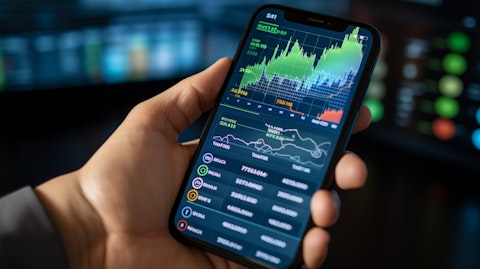Mitek Systems, Inc. (NASDAQ:MITK) Q2 2025 Earnings Call Transcript May 8, 2025
Mitek Systems, Inc. beats earnings expectations. Reported EPS is $0.36, expectations were $0.26.
Operator: Good afternoon and welcome to the Mitek’s Fiscal 2025 Second Quarter Earnings Conference Call. All participants will be in listen-only mode. [Operator Instructions]. Please note this event is being recorded. I would now like to turn the conference over to Todd Kehrli of PondelWilkinson. Please go ahead.
Todd Kehrli: Thank you, operator, good afternoon and welcome to Mitek’s fiscal 2025 second quarter earnings conference call. With me on today’s call are Mitek CEO, Ed West and CFO David Lyle. Before I turn the call over to Ed, I’d like to cover a few quick items. Today Mitek issued a press release announcing its financial results for its fiscal 2025 second quarter ended March 31, 2025. That release is available on the company’s website at miteksystems.com. This call is being broadcast live over the internet for all interested parties and the webcast will be archived on the investor relations page of the company’s website. I want to remind everyone that on today’s call, management will discuss certain factors likely to influence the business going forward, any factors discussed today that are not historical facts, particularly comments regarding our long-term prospects and market opportunities should be considered forward-looking statements.
These forward-looking statements may include comments about the company’s plans and expectations for future performance. Forward-looking statements are subject to a number of risks and uncertainties which could cause actual results to differ materially. We encourage all our listeners to review our SEC filings, including our most recent 10-Ks and 10-Qs for a complete description of these risks. Our statements on this call are made as of today, May 8, 2025, and the company undertakes no obligation to revise or update publicly any forward-looking statements contained herein, whether as a result of new information, future events, changes in expectations, or otherwise. Additionally, throughout this call, we’ll be discussing certain non-GAAP financial measures, today’s earnings release, and the related current report on Form 8-K describe the differences between our GAAP and non-GAAP reporting and present the reconciliation between the two for the periods reported in the release.
With that said, I’ll now turn the call over to Mitek ‘s CEO, Ed West.
Ed West: Thank you, Todd, and good afternoon, everyone. I would like to begin with a brief overview of Mitek, who we are, the problems we solve, and why our role is more critical than ever in today’s digital world. Mitek is a global leader in identity verification and fraud prevention, trusted by over 7,000 organizations worldwide, including top banks, fintechs, telecoms, and marketplaces. We earned that trust by pioneering Mobile Check Deposit, a technology that now enables about 1.2 billion mobile deposit transactions each year. That same technology was built to securely capture and process sensitive data using any camera-enabled device is what paved the way for our leadership in digital identity. Today, our capabilities have expanded to include payment fraud detection, powered by an industry-leading consortium of financial institutions, as well as identity verification and authentication, advanced biometrics, and detection of deepfakes and synthetic fraud.
In high-assurance industries, where precision, integrity, and regulatory compliance are essential, we help our customers stay ahead of evolving threats before they cause harm. The rise of generative AI is fundamentally reshaping the threat landscape, giving fraudsters access to powerful, low-cost tools that can mimic identities, forge documents, and bypass traditional defenses. It’s never been easier or cheaper for bad actors to launch attacks. Fraud has essentially been democratized. That’s why Mitek’s mission to provide secure, real-time identity and fraud prevention is more relevant and more necessary than ever. As I noted earlier this year, our priorities this year have been to drive organic growth, increase the percentage of SaaS revenue, expand margins, and increase free cash flow conversion.
With that context, here are four key takeaways from the second quarter, each aligned with the transformation framework we outlined on prior calls. First, we made tangible progress strengthening the foundation for scalable, profitable, organic growth by improving sales execution, our technology platform, and operational efficiency. Second, our identity portfolio continues to build momentum, reaching over $71 million in the last 12 months’ revenue, driven by strong transaction growth. Third, Check Fraud Defender continues to expand rapidly. We now have data sets on 23% of U.S. checking accounts up meaningfully from the last quarter. And fourth, we are enforcing financial discipline, lowering spend intensity while delivering meaningful EBITDA leverage and improving free cash flow, all under an umbrella of strict oversight of capital allocation.
Now let me discuss each of these, starting with our efforts to strengthen the foundation of our company. In the second quarter, we made meaningful progress in identity sales execution, notably without adding headcount. We have restructured compensation plans to focus on driving high-quality, recurring revenue, aligning frontline incentives with our strategic goals. This shift is already paying off, with growth driven by new customer wins, expansion with existing accounts, and increased adoption of newer identity and fraud-related products, all supported by tighter, ideal customer profile alignment and a more focused go-to-market approach. On the R&D front, we are leveraging our AI and machine learning resources to help manage the business better.
We launched a fully modernized document onboarding system, reducing document onboarding cycle times. When a government agency introduces a new document, such as a redesigned driver’s license, our systems initially flags it as unclassified because it’s unfamiliar. This triggers manual reviews, increasing operational burden, and slowing the user experience. With the recent system upgrades, we’ve improved new document cycle times, reducing reliance on manual intervention and enabling faster, more scalable support for global document libraries. This rollout began in the U.S. and will soon expand to Europe and the U.K., improving automation rates and strengthening our product scalability in high-assurance markets. These efforts also complement our broader initiative to automate more transactions, enhance scalability, and streamline the customer experience.
In addition, we strengthen our leadership team with the appointment of Garrett Gafke as COO. A proven operator in identity and fraud prevention, Garrett will focus on scaling automation, product development, and data analytics, all core to our path toward durable, profitable growth. Now, turning to identity, we saw meaningful progress in the two key drivers of profitability, stronger transaction mix and a greater automation, resulting in the need for fewer manual review agents. We’re tracking towards our $80 million to $85 million fulcrum point for identity, with the last 12 months’ revenue at $71.4 million exiting the second quarter. As a reminder, improvements in unit economics, especially gross profit per transaction, could lower that breakeven threshold over time.
MiVIP continued to outpace the rest of the portfolio, further shifting the transaction mix. Over half of identity journeys now include multiple verification steps, such as face match, liveness, SMS, and deepfake detection, versus the single-step journeys typical of MobileVerify. This richer signal set is driving higher revenue per journey and stronger unit-level profitability. On the automation front, improved AI models reduced manual reviews, driving down per transaction cost and lifting our services’ gross margin by 230 basis points over last year, advancing us further along our path to scalable, sustainable profitability and identity. Another key milestone this quarter is the increasing traction with MyPass, our biometric authentication solution, which replaces credentials with biometric login tied to a verified identity, critical for high-assurance sectors.
Finally, we began expanding our relationships with existing customers by adding real-time deepfake detections and other synthetic attacks through our digital fraud defender solution. These advanced signal-rich solutions position Mitek to lead in an increasingly AI-driven fraud landscape. To summarize, identity growth is being driven by two key trends, both directly aligned with our strategy. First, identity journeys are becoming more layered, with customers adding additional verification and authentication steps to strengthen security. This shift reflects the increasing complexity of digital identity and demonstrates that we are successfully executing on our strategy. And second, we believe usage of our platform will continue to expand beyond initial onboarding to include re-authentication throughout the customer lifecycle, such as during wire transfers or high-risk activities, where high-assurance businesses rely on Mitek’s advanced capabilities like liveness detection and biometrics and authenticate against a verified identity.
Now, turning to the third key takeaway. Our Check Fraud Defender Solution made good progress in Q2 across both direct and partner channels. ACV grew to nearly 13 million, and we now have data set coverage on approximately 23% of all U.S. checking accounts, up from 18% when we last updated the market. This coverage is a leading indicator of value for the consortium members, as well as future growth. It allows us to engage with banks whose checks we already see through consortium operations. On the direct side, we closed two major relationships, including a top 10 and a top 50 U.S. bank. We also advanced our relationship with another top 10 bank currently using our on-premise solution. This institution is now running a full-volume pilot across mobile, branch, ATM, and end-clearing channels, highlighting growing interest in our real-time cloud-based consortium model.
On the partner side, which helps us serve the broader Long Tail regional banks, Abrigo added multiple new clients during this quarter, and another new partner signed 30 new FIs. Our pipeline is solid, and we’re in advanced conversations with additional potential partners. While sales cycles and banking remain long and complex, the payoff is high. Our solutions become mission-critical once deployed, generating strong lifetime value and long-term recurring revenue. And that brings us to our fourth and final takeaway, continued progress towards a more durable, growing, and cash-generative business model. SaaS revenue grew 15% year-over-year in Q2 and now accounts for 40% of total last 12 months revenue, up from 39% last quarter, evidence of our steady transition to a more recurring revenue model.
We’re also driving sharper financial discipline. Non-GAAP cash adjustments were down to a low single-digit percentage point of revenue from 9% a year ago, highlighting stronger execution and cost control. Over the last 12 months, we’ve generated $47 million in free cash flow on $56 million of adjusted EBITDA and 86% conversion rate. This cash strength gives us flexibility to prudently invest in innovation, strengthen our balance sheet, and return capital to shareholders. Dave will speak more about our capital allocation strategy a little later. Now, before I wrap up, I want to zoom out and speak briefly about the broader opportunity in digital identity and fraud prevention. As we strengthen our position in this market, it’s important to reflect on how the landscape is evolving and why Mitek is well-positioned to lead.

There are three primary ways to verify or authenticate someone’s identity. Something you know, such as a password or a PIN, something you have, such as a phone or an ID, or something that you are, such as biometrics and behavioral signals. Yet most of the world, including high-assurance industries, still rely on the first two. While these methods remain important, they are no longer sufficient on their own. In today’s AI-driven threat environment, standalone authentication must give way to a layered, signal-rich approach. The gap between the sensitivity of digital transactions and the strength of protections is significant and widening. Mitek’s view is that the identity must be verified directly by something you are and continuously, not just at login.
That means layering biometrics, behavioral data, and proprietary identity signals to truly know who a user is. But even biometrics alone aren’t enough. According to EDF Research Institute, the vast majority of systems today cannot detect deepfakes. Our technology is built specifically to mitigate that gap. Broad today is global, scalable, and alarmingly accessible. What was once limited to skilled criminals is now powered by off-the-shelf toolkits and cheap generative AI, making advanced attacks available to anyone, anywhere, and at a low cost. Across my recent conversations with customers and prospects in North America, the United Kingdom, and Europe, the message has been consistent, that the threat is real, growing, and reshaping enterprise priorities.
At Mitek, we’re building a unified platform that combines fraud prevention, identity verification, and biometric authentication to help organizations stay secure in an AI-driven world. This platform approach is driving broadening demand, deeper customer engagement, and turning our innovation into durable, profitable growth. And with that, I’d like to turn it over to Dave for financial highlights and our outlook.
Dave Lyle: Thanks, Ed. I’ll start by walking through our results for the quarter, highlighting the drivers behind our performance, and from there, I’ll share some additional insights into how we’re approaching the balance of the year. First, our fiscal Q2 ’25 results. Total revenue reached a record $51.9 million, up 11% year-over-year in the second quarter. As expected, deposit products revenue increased 14% year-over-year, driven by strong mobile deposit renewal activity. Our identity products revenue increased by 4% year-over-year, and was highlighted by strong 9% year-over-year growth in identity SaaS revenue, and continued strength in our identity transaction volumes. Our non-GAAP gross profit for the quarter was $45.6 million, representing an 88% non-GAAP gross margin, and adjusted EBITDA came in at $20.2 million, representing a 39% margin.
Both slightly exceeded our expectations due to the mixed benefits of revenue outperformance, and our near 100% gross margin deposit software license business, combined with better-than-expected operating expenses, due to the company-wide focus on cost controls. Turning now to the specifics of our revenue performance, let’s start with deposit products. Deposits revenue grew 14% year-over-year to $33.7 million, primarily due to a 10% increase in our deposit software license revenue, relating specifically to our mobile deposit and check intelligence software products. This increase was consistent with expected renewal patterns as customers returned to repurchase mobile check deposit transactions. As we’ve noted before, due to the lumpiness inherent to term license revenue, which makes up 70% of deposits products revenue, we encourage investors to focus on longer-term trends.
To that end, deposit software license revenue for the last 12 months ending fiscal Q2 ’25 was $73 million, up from $68 million for the last 12 months ending fiscal Q2 ’24, and consistent with the longer-term average of $70 million. This stability reflects our consistent $1.2 billion transaction run rate, which continues to offset broader declines in check usage as mobile adoption grows. In addition to strong performance in license revenue, deposit maintenance revenue grew 10% year-over-year, reflecting a healthy cadence of contract renewals following continued strength in software licensing. While Check Fraud Defender remains in the early stages of monetization, we’re encouraged by its growing traction with deposit SaaS revenue rising 64% year-over-year, driven by increased adoption of this solution.
Overall, it was a strong quarter for our deposits products, supported by robust license renewals, solid maintenance growth, and accelerated SaaS momentum. Now turning to our identity product portfolio, which grew 4% year-over-year to $18.2 million, driven by a 9% increase in identity SaaS revenue. This growth was supported by continued strong transaction volumes across both MiVIP and Mobile Verify, consistent with trends we’ve seen in recent quarters. While Q1 benefited from unusually high overage activity at premium pricing tiers, we’re pleased to see the underlying strength of the business continue in Q2. We’re also seeing an increasingly diversified mix of verification steps attached to each identity transaction on MiVIP, such as face match, liveness, and SMS verifications.
While these can carry lower per-unit pricing, they boost engagement and volume, reflecting how our platform is being used in more complex workflows. Given the ongoing mix shift towards lower priced but higher volume verification steps, we view gross profit dollars as an informative indicator of our underlying unit economics. In Q2, gross profit from our services and other revenue category, which includes identity SaaS, increased nearly 18% year-over-year, more accurately reflecting the expanding contribution and improving efficiency of our identity offerings. Turning to total SaaS revenue, we continue to see strong performance across both our fraud and identity SaaS offerings, with total SaaS revenue growing 15% year-over-year. As Ed noted, we’re making solid progress towards our goal of SaaS revenue representing a majority of our business.
Last 12 months, our LTM, SaaS revenue now accounts for 40% of total revenue, up from 35% a year ago. Identity SaaS revenue may experience quarterly fluctuations based on customer overage activity as seen in Q1. Moving down the P&L, we maintain strong unit economics, achieving an 88% non-GAAP gross margin for the quarter. This was driven by our near 100% gross margins on our software license revenue, mostly mobile deposit, and a notable 75% gross margin on our services and other revenue, mostly Mobile Verify and MiVIP, reflecting continued improvement and up 230 basis points year-over-year. These results reflect the financial benefits of our efforts to increase automation, improve cost efficiencies, and drive cultural integration, particularly within our identity portfolio.
Non-GAAP operating expense for the quarter totaled $25.7 million, a $1.7 million sequential increase from fiscal Q1. The increase was primarily driven by higher R&D, as well as continued investment in marketing and cloud-related initiatives. We are particularly pleased with our progress on G&A expenses. Non-GAAP G&A fell $1.8 million year-over-year to 15% of revenue, down from 21% a year ago. This improvement was widespread and reflects our ongoing efforts to build a more scalable and efficient G&A organization while maintaining strong controls and governance. This discipline is also evident in the declining gap between our non-GAAP and GAAP operating expenses, which reflects fewer non-recurring cash items. The $8.3 million difference between our non-GAAP and GAAP operating expenses in Q2 reflects a half million dollars in cash adjustments and $7.8 million in non-cash accounting adjustments.
This represents a significant improvement from Q2 fiscal year ’24, when cash adjustments totaled $4.4 million. The $3.9 million year-over-year reduction reflects lower non-recurring audit fees, legal costs, executive transition expenses, and restructuring charges. To tie this all together, adjusted EBITDA for Q2 ’25 reached a record $20.2 million, reflecting a 52% increase year-over-year and representing a 39% adjusted EBITDA margin. After factoring in other income, interest expenses, and taxes, this equates to $16.7 million in non-GAAP net income or $0.36 for diluted share based on 46.6 million diluted shares outstanding. Turning to our balance sheet and capital allocation strategy, over the last 12 months, we generated $47.1 million in free cash flow and returned $27.2 million to shareholders through share repurchases.
These two factors account for most of the change in our cash and investments balance, which increased by $22.1 million over the past 12 months. Importantly, we ended the quarter in a near net cash position with $152.4 million in cash and investments against $155.3 million in face value of convertible senior notes due in February ’26. Given the low 75 basis points coupon and the notes conversion feature is deep out of the money, we continue to earn a favorable spread by holding cash and plan to wait as long as practical before redeeming. To support this strategy and strengthen our overall capital allocation position, yesterday, we closed a $100 million senior credit facility with Silicon Valley Bank, a division of First Citizens Bank. This includes a $75 million delayed draw term loan available in tranches through February 2026 to retire our convertible notes and a $25 million revolver for general corporate purposes.
Both mature in May 2030 and are structured with favorable terms, extended duration of five years, and ample flexibility to support our long-term growth and capital allocation plans. Our strong financial position supports a disciplined, opportunistic capital allocation strategy, enabling us to balance share purchases when valuation is compelling with high return investments and growth, all with a singular focus on maximizing free cash flow per share. Before turning to our outlook, a brief note on the macro environment. While the broader environment remains uncertain, we continue to see resilience in our business. As a software company today, we are largely insulated from trade-related disruptions, and security-related IT spending has historically remained steady even in constrained budget environments.
Our global customer base also provides diversification against regional volatility, and we have not seen any cancellations tied to the macro backdrop. That said, given potential for evolving macroeconomic headwinds, we are approaching our fiscal 2025 outlook with appropriate discipline and caution. With regard to revenue, we are maintaining our full-year revenue guidance range of $170 to $180 million. Based on the midpoint of our guidance and typical seasonal patterns, we expect Q3 revenue to modestly exceed Q4, reflecting normal customer buying behavior and the expected timing of several term-based license renewals. On the profitability front, we are raising our full-year adjusted EBITDA margin guidance range to 26% to 29%, up from our prior range of 25% to 28%.
This increase reflects our strong first-half performance and the sustained impact of recent efficiency improvements while still preserving flexibility to invest strategically. For fiscal Q3, we expect non-GAAP operating expenses to be in the range of $26 million to 27 million, with depreciation expense around 70 basis points of revenue. While we continue to manage costs with discipline, we anticipate modest sequential increases in our non-GAAP operating expenses through year-end as we selectively ramp hiring, invest in go-to-market initiatives, and support innovation across our product portfolio. With that, I’ll turn the call back over to the operator for questions.
Q&A Session
Follow Mitek Systems Inc (NASDAQ:MITK)
Follow Mitek Systems Inc (NASDAQ:MITK)
Receive real-time insider trading and news alerts
Operator: We will now begin the question and answer session. [Operator Instructions]. Our first question will come from Jake Roberge with William Blair. You may now go ahead.
Jake Roberge: Yes, thanks for taking the questions, and really nice results on both the top and bottom line. Ed, now that you’ve been at Mitek for a few quarters, can you talk about some things that have gone well thus far and maybe a few things that have been a bit more difficult for you? And then, obviously, some turbulent times in the market, so we’d love to get your take on what you’re seeing from customers. Sounds like things have been largely stable, but it would be great to hear what you saw from some of your more usage or transactional-based businesses as you progressed through the month of April?
Ed West: Sure. Well, thanks, Jake. I appreciate the word, and frankly, it all goes to the employees across Mitek, around the world who just did a terrific job this past quarter, and frankly, since I’ve been here for the six months. A lot was underway, and a lot of execution has occurred, and so we couldn’t be more pleased with the results and attraction that we were able to see and realize this past quarter. Going to your question about, you know, what we’re hearing, you know, from customers and prospects, frankly, it’s one of the things I enjoy doing the most is getting and meeting with customers, prospects, whether it be here in North America, Canada, UK, Europe, and frankly, learning about what’s working, what’s not, the strategy, where we’re going, and understanding their needs, and frankly, that’s shaping a lot of the feedback, the comments that you heard on my prepared comments about where we’re going, what we’re seeing, the focus on fraud and identity, and pulling that together across our platform.
So our priorities are highly aligned to what we’ve heard in the market, what I’ve heard, and then just executing against that. And so one of the things that I’ve felt, you know, most encouraged about it coming here, first and foremost, the company’s heritage and experience, the expertise, the trust earned over decades of working with financial institutions, over 7,000 FIs, and combining that with the technological capabilities, the various software applications, the people, the technical skills that we have, in particular, on identity and the biometric side, combining those things together to address the evolution of fraud in the market is what really sets us apart from others, and I’ve heard that loud and clear from customers and prospects, and it’s how we’re moving our technology.
So think of us as, around fraud and identity, this coming together from payments to verification to authentication across the platform. On the last part of your question, just to get about, how are things progressing, so encouraging. As Dave mentioned that, we haven’t seen cancellations or something for the macro environment. Frankly, I think with fraud, it’s moving in our direction, which is highly encouraging to us. I will say that, we’re still gaining our sea legs, history, one quarter, we’re not going to ring the bell after one quarter, but it’s a nice one to have behind us. Things will go up and down over time, but we really like the hand that we’ve been dealt and look forward to executing it against that going forward.
Jake Roberge: Okay, that’s helpful, and then just on guidance, you obviously had a strong quarter and good to see the EBITDA raise, but on the maintain top line guide, can you talk about whether there were any kind of pull forwards that helped drive the strength in the quarter or whether that maintain top line guide is really just reflecting some added prudence related to the current macro environment?
Dave Lyle: Yes, I can take that. Yes, we did see one very large mobile deposit customer order earlier than we expected in Q2 rather than in Q3, that was probably the majority of the overachievement versus our expectations. There was another customer that actually ordered on the mobile deposit side more than we expected. That’s a good thing. So, we were excited to see that happen too.
Jake Roberge: Okay. And then if I could just sneak one more in, great to hear you now have data on I think 23% of checking accounts. I think the target was to reach 20 million ACV by the end of the year, so could you just talk about how you’re progressing toward those targets?
Ed West: Sure. So, on the first part about that around the data sets on now 23%, and that’s up significantly. The volumes that we’re seeing going through our platform are ramping pretty substantially. More and more partners, as I mentioned, now both direct and indirect through partners coming in, more and more information. Those are all great leading indicators of what’s ahead, and so we like the progress. Of course, I would say, and going back, Jake, one of your questions from several questions ago about one of the things to see that’s on the frustrating part, these things take time, the time. We like to tell time by a watch, not by a calendar, and how do we accelerate the cycles and the process to bring some of these to recognize revenue sooner and close them out and get them up and running, but we’re in it for the long haul, so some of these things take longer.
But we like the direction. We like where we’re headed and feel good about moving forward against our goals.
Jake Roberge: Very helpful. Thanks for taking the questions, and congrats on the solid results.
Ed West: Thanks, Jake.
Operator: Our next question will come from Mike Grundle with Northland Securities. You may now go ahead.
Unidentified Analyst: Hey, guys. This is Luke on for Mike. Congrats on the quarter. Just wanted to touch on your earlier comments on the kind of modernized document onboarding system, wondering if there’s any sort of way to quantify just how much quicker this process is with this sort of automation and cycle times?
Ed West: Good afternoon, Luke. Thanks for the acknowledgement. It’s like I said, we’ve just done it in the U.S. and now we’re moving to broaden that out over the U.K. and Europe. It’s a meaningful acceleration, in particular because when it takes so long, when our systems are seen as unclassified, we’re having to then do a lot of this manually. It’s taking longer for customers and the customer experience, so the more we can accelerate and rapidly accelerate that, the better. I don’t have data for you on exactly the percentage. Over time, we’ll see it. I don’t want to be premature on exactly what the number would be, but it’s potentially meaningful from cycle time, and then, again, it goes back to a line that we talked about earlier.
It’s a great acknowledgement for our terrific machine learning, AI resources, and R&D that, hey, looking at the business, how do we continue to improve profitability, scalability, automate different functions across the system? This is something the team jumped on and brought to life, so we’ll keep you apprised.
Unidentified Analyst: Got it. Thanks for that, and then just on fast revenue, up 15% year-over-year, now accounts for 40% of revenue mix, I think that was up from 39 last quarter, I guess just how do you kind of see this mix trending in the years to come, and where do you kind of expect that to normalize that at the current business?
Ed West: Well, what we outlined at the earlier part of the year is that our goal was to going into ’26 as soon as we could, to see the majority of our revenue, so more than half of that coming from SaaS related. Basically what’s driving this, or our fraud platform, focusing on payments with checks as well as all the identity, all the SaaS side on the identity verification, the biometric layered into the products that are all SaaS. So it’s really a combination of those that are driving that, and we just aspire to — we want all sides of the P&L to go up, but we’d just like to see that SaaS become a majority to add more durability and consistency to our top side.
Dave Lyle: Yes, and the reason we have optimism around it is those are the products that are kind of moving from their nascent stage and starting to really grow, so that’s where we have the most growth potential, and those are all SaaS products.
Unidentified Analyst: Okay, got it. Thanks for the call there, guys, and appreciate you taking the questions, and congrats on the quarter.
Ed West: Thanks.
Operator: [Operator Instructions] Our next question will come from Derek Greenberg with Maxim Group LLC. You may now go ahead.
Derek Greenberg: Hey, guys, congrats on the quarter. My first question is just on second half seasonality. I know you outlined at the beginning of the year that you expected this to be similar to ’24, where 26% of revenue was in the third quarter and 25% was in the fourth quarter. I heard you talk about how some of that order volume was pulled into the second quarter, and there was also higher anticipated revenue from another customer. I was just wondering how the pacing of this has changed, if at all, going forward?
Dave Lyle: No, typically, the answer is it’s not changing much from what we’ve guided previously. Typically, we see Q1 and Q4 as our lower quarters. That’s mostly related to mobile deposit, software license revenue, which fluctuates, and it’s just a deal-timing issue more than anything else. I said in my remarks that we thought Q3 would be a little higher than Q4, which follows the same pattern that we drew before.
Derek Greenberg: Got it. Thanks. That’s helpful. And then, returning to your software as a service revenue goal of more than half of total revenue. Is that for calendar ’26 or fiscal 26? Can you just be more specific there?
Dave Lyle: Yes, that’s a goal of ours. We didn’t set necessarily for this year, but something that we do have line of sight, we believe, too.
Derek Greenberg: Okay, got it. And then, I noticed you guys had put out a press release earlier just talking about a submission to an opportunity with the Department of Homeland Security. I was wondering if you could just talk about this a little bit more?
Ed West: Actually, I think what you’re referring to is something that we put out, where the Department of Homeland Security ran an assessment looking at various liveness applications and biometric, and where we had submitted on that, as well as others doing both active and passive liveness, and assessing those relative to the market. The great news is our results were terrific. We led the industry in terms of responsiveness with the positives and picking up fraud, as well as how fast it was, and then the potential latency from other systems. So we came out ahead. It was done on a blind basis, so you only knew what your own results were. But team did a terrific job and really just recognizes our passive liveness capabilities and the need for those now is a recognition from the market on the DHS, looking at that, assessing that, and seeing that Mitek Solutions were leading the market.
Derek Greenberg: Okay, that makes sense. And then just my final question. Thinking of organic growth and your selling and marketing initiatives, I was wondering how much of growth we should expect to come from new business versus cross-sell and expansion with current clients?
Ed West: I would just say the answer is yes. I mean, it’s a focus on organic. We want to continue to add new logos and new relationships like we have been and continue to expand with our existing relationships. We have terrific ones. We’re rolling out new products, new solutions that are new to the market and obviously very timely with some of the need and the fraud that we’re seeing, particularly around the biometrics, the liveness that we just talked about, and frankly, some that’s been out there but now is beginning to see its day is around authentication that’s authenticating biometrically back to a verified identity and something that we’re fairly unique in and can offer. In my visits with customers and prospects, this is what we’ve been hearing and very encouraged about our position on that.
And our focus as a company, as I outlined two quarters ago and as Dave and I have talked about, we’re focused on organic growth and doing whatever is necessary to continue to accelerate that. And honestly, that’s going to go up and down quarter-to-quarter. Some peers look better than others, but we’re encouraged about the pace right now.
Derek Greenberg: Okay. Great. Thanks for the color.
Operator: This concludes our question and answer session. I’d like to turn the conference back over to Todd Kehrli for any closing remarks.
Todd Kehrli: Thank you, operator, and thank you all for joining us today and for your continued support. As always, if you have any follow-up questions, please contact me and we can set up a follow-up call. Thanks and have a great rest of your day.
Ed West: Very good. Thank you.
Operator: The conference is now concluded. Thank you for attending today’s presentation. You may now disconnect.
Follow Mitek Systems Inc (NASDAQ:MITK)
Follow Mitek Systems Inc (NASDAQ:MITK)
Receive real-time insider trading and news alerts




